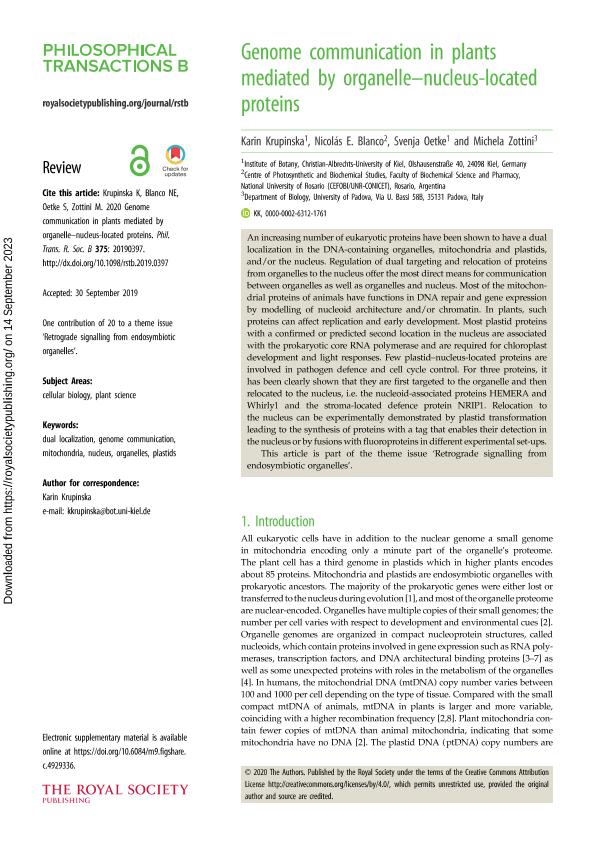Mostrar el registro sencillo del ítem
dc.contributor.author
Krupinska, Karin
dc.contributor.author
Blanco, Nicolás Ernesto

dc.contributor.author
Oetke, Svenja
dc.contributor.author
Zottini, Michela
dc.date.available
2023-09-14T18:31:05Z
dc.date.issued
2020-05
dc.identifier.citation
Krupinska, Karin; Blanco, Nicolás Ernesto; Oetke, Svenja; Zottini, Michela; Genome communication in plants mediated by organelle–nucleus-located proteins; The Royal Society; Philosophical Transactions of the Royal Society B: Biological Sciences; 375; 1801; 5-2020; 1-16
dc.identifier.issn
0962-8436
dc.identifier.uri
http://hdl.handle.net/11336/211578
dc.description.abstract
An increasing number of eukaryotic proteins have been shown to have a dual localization in the DNA-containing organelles, mitochondria and plastids, and/or the nucleus. Regulation of dual targeting and relocation of proteins from organelles to the nucleus offer the most direct means for communication between organelles as well as organelles and nucleus. Most of the mitochondrial proteins of animals have functions in DNA repair and gene expression by modelling of nucleoid architecture and/or chromatin. In plants, such proteins can affect replication and early development. Most plastid proteins with a confirmed or predicted second location in the nucleus are associated with the prokaryotic core RNA polymerase and are required for chloroplast development and light responses. Few plastid–nucleus-located proteins are involved in pathogen defence and cell cycle control. For three proteins, it has been clearly shown that they are first targeted to the organelle and then relocated to the nucleus, i.e. the nucleoid-associated proteins HEMERA and Whirly1 and the stroma-located defence protein NRIP1. Relocation to the nucleus can be experimentally demonstrated by plastid transformation leading to the synthesis of proteins with a tag that enables their detection in the nucleus or by fusions with fluoroproteins in different experimental set-ups. This article is part of the theme issue ‘Retrograde signalling from endosymbiotic organelles’.
dc.format
application/pdf
dc.language.iso
eng
dc.publisher
The Royal Society

dc.rights
info:eu-repo/semantics/openAccess
dc.rights.uri
https://creativecommons.org/licenses/by/2.5/ar/
dc.subject
DUAL-LOCALIZATION
dc.subject
MITOCHONDRIA
dc.subject
NUCLEUS
dc.subject
PLASTIDS
dc.subject.classification
Bioquímica y Biología Molecular

dc.subject.classification
Ciencias Biológicas

dc.subject.classification
CIENCIAS NATURALES Y EXACTAS

dc.title
Genome communication in plants mediated by organelle–nucleus-located proteins
dc.type
info:eu-repo/semantics/article
dc.type
info:ar-repo/semantics/artículo
dc.type
info:eu-repo/semantics/publishedVersion
dc.date.updated
2023-09-12T18:14:10Z
dc.journal.volume
375
dc.journal.number
1801
dc.journal.pagination
1-16
dc.journal.pais
Reino Unido

dc.journal.ciudad
Londres
dc.description.fil
Fil: Krupinska, Karin. Christian Albrechts Universitat Zu Kiel.; Alemania
dc.description.fil
Fil: Blanco, Nicolás Ernesto. Consejo Nacional de Investigaciones Científicas y Técnicas. Centro Científico Tecnológico Conicet - Rosario. Centro de Estudios Fotosintéticos y Bioquímicos. Universidad Nacional de Rosario. Facultad de Ciencias Bioquímicas y Farmacéuticas. Centro de Estudios Fotosintéticos y Bioquímicos; Argentina
dc.description.fil
Fil: Oetke, Svenja. Christian Albrechts Universitat Zu Kiel. Matematisch Naturwissenschaftliche Fakultat.; Alemania
dc.description.fil
Fil: Zottini, Michela. Universita Di Padova. Dipartimento Di Biología; Italia
dc.journal.title
Philosophical Transactions of the Royal Society B: Biological Sciences

dc.relation.alternativeid
info:eu-repo/semantics/altIdentifier/doi/http://dx.doi.org/10.1098/rstb.2019.0397
dc.relation.alternativeid
info:eu-repo/semantics/altIdentifier/url/https://royalsocietypublishing.org/doi/10.1098/rstb.2019.0397
Archivos asociados
